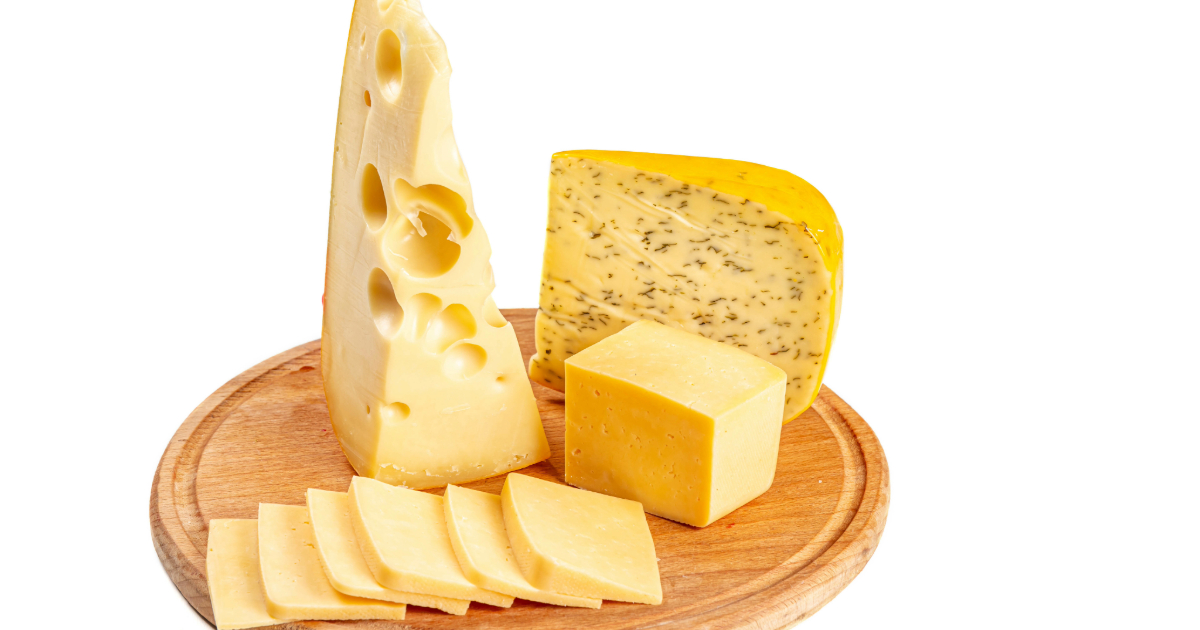Swiss cheese and Jarlsberg cheese have a lot in common. They are both semi-hard cheeses with a pale yellow color and distinctive holes or "eyes".

However, there are some key differences that set these two cheeses apart.
Origins and History
Swiss cheese refers to a group of cheeses originating in Switzerland, with Emmentaler being the most well-known. Emmentaler has been produced in Switzerland since the 18th century using milk from grass-fed cows grazing in the nutrient-rich valleys and Alpine meadows.
Jarlsberg was first produced in Norway in the 1850s by farmer Anders Larsen Bakke. He created it using techniques learned from Swiss cheese makers. Commercial production of Jarlsberg ceased for a period but was later revived in the 1950s by researchers at the Norwegian University of Life Sciences.
So while Swiss cheese has a longer history, Jarlsberg was modeled after the Swiss method. Both cheeses are now popular worldwide.
Flavor Profiles
Swiss cheese like Emmentaler has a mild, sweet and nutty flavor. It starts out mild when young then develops more complexity with aging. There are grassy, buttery notes complemented by a distinctive nuttiness.
Jarlsberg also has a nutty, sweet flavor, but it tends to be stronger and fruitier than Swiss. It has a caramel-like sweetness and a more pronounced nuttiness. The flavor has been described as reminiscent of hazelnuts.
So while nuttiness is a common thread, Jarlsberg delivers bolder, more well-rounded flavor in the palate.
Texture and Appearance
Traditional Swiss cheese has a smooth, supple, elastic texture. Emmentaler specifically has a firm yet pliable texture with a medium-hard consistency.
Jarlsberg has a similar smooth, semi-soft texture though it tends to be more elastic and pliable than Swiss. It has larger, irregular holes compared to the generally uniform holes of Swiss cheese.
Both have the distinctive holes, or “eyes”, created by pockets of carbon dioxide gas. But Jarlsberg’s holes tend to be bigger.
In terms of color, Swiss cheese and Jarlsberg have a similar pale yellow hue.
Production Process
Swiss and Jarlsberg cheeses are both made using an Alpine cheesemaking method that originated in the mountains. This process involves heating and pressing the cheese which expels moisture and allows for longer preservation.
However, production methods differ in that Swiss cheese relies on microbes naturally present in raw milk while Jarlsberg uses commercial cultures added to pasteurized milk. This contributes to the differences in flavor and appearance.
Nutrition
Both Swiss and Jarlsberg deliver high amounts of calcium and protein. However, Jarlsberg contains lesser amounts of fat and sodium per serving compared to Swiss cheese.
For example, a 1 oz (28g) serving of Swiss cheese delivers about 104 calories and 9g of fat while the same amount of Jarlsberg has only 70 calories and 3.5g of fat.
So if you’re looking to limit fat or calories without compromising nutrition, Jarlsberg may have an edge over Swiss cheese.
Uses in Cooking
Thanks to their smooth, pliable texture and excellent melting qualities, both Jarlsberg and Swiss cheese work wonderfully in hot dishes like:
- Fondue
- Grilled cheese sandwiches
- Soups and sauces
- Quiches
- Gratins
- Pizza
Jarlsberg is the milder and sweeter of the two so it adapts well to a wide variety of ingredients. Its versatility makes it an excellent table cheese as well.
Swiss cheese delivers bolder, more complex flavor that intensifies with age. Its grassy, nutty notes can take melty baked dishes to the next level.
Price Differences
Many factors influence the price differential between Jarlsberg and Swiss cheese.
On average, Swiss cheese costs less than Jarlsberg. As a specialty Norwegian cheese made using a proprietary production method, Jarlsberg is considered more of an artisanal, premium product.
Higher raw ingredient standards including the use of richer milk and aging for flavor development also drive up costs. Import fees can tack on additional expense for Jarlsberg outside Europe.
However, there are some affordable mass-produced versions of Jarlsberg made in the Americas and elsewhere overseas.
FAQs
What’s the difference between Jarlsberg and Emmental cheese?
Emmental is the Swiss cheese that Jarlsberg was modeled after. While they share some traits like large holes and a semi-soft texture, Jarlsberg tends to be sweeter and more nutty while Emmental has a milder, grassier profile.
Is Jarlsberg better than Swiss cheese?
It depends on personal taste preferences. Jarlsberg and Swiss cheese have minor textural differences and distinct flavor profiles. Jarlsberg offers a more well-rounded, nuanced flavor but Swiss cheese has an inimitable nutty intensity.
Can Jarlsberg replace Swiss in fondue?
Absolutely! The smooth, melty quality of Jarlsberg makes it an excellent choice for cheese fondue. Its mild flavor allows other ingredients to shine. For those who find Swiss cheese too strong, Jarlsberg’s sweet nuttiness strikes the right balance.
Is Jarlsberg good for sandwiches?
With its semi-soft texture, sweet nutty flavor and good melting properties, Jarlsberg excels as a sandwich cheese. It’s versatility allows it to pair well with both sweet and savory ingredients. A classic pairing is Jarlsberg with pastrami or turkey on rye bread.
Is Jarlsberg healthier than Swiss cheese?
Jarlsberg contains slightly lower amounts of overall fat and saturated fat per serving versus Swiss cheese. Notably, it provides high amounts of calcium and protein. However, nutrition can vary slightly across producers. Both can be enjoyed in moderation as part of a balanced diet.
Conclusion
Jarlsberg and Swiss cheese are quite alike.
While the Norwegian cheese took inspiration from Switzerland’s Emmental, it has made a global name for itself based on its own unique taste, texture and nutrition profile.

